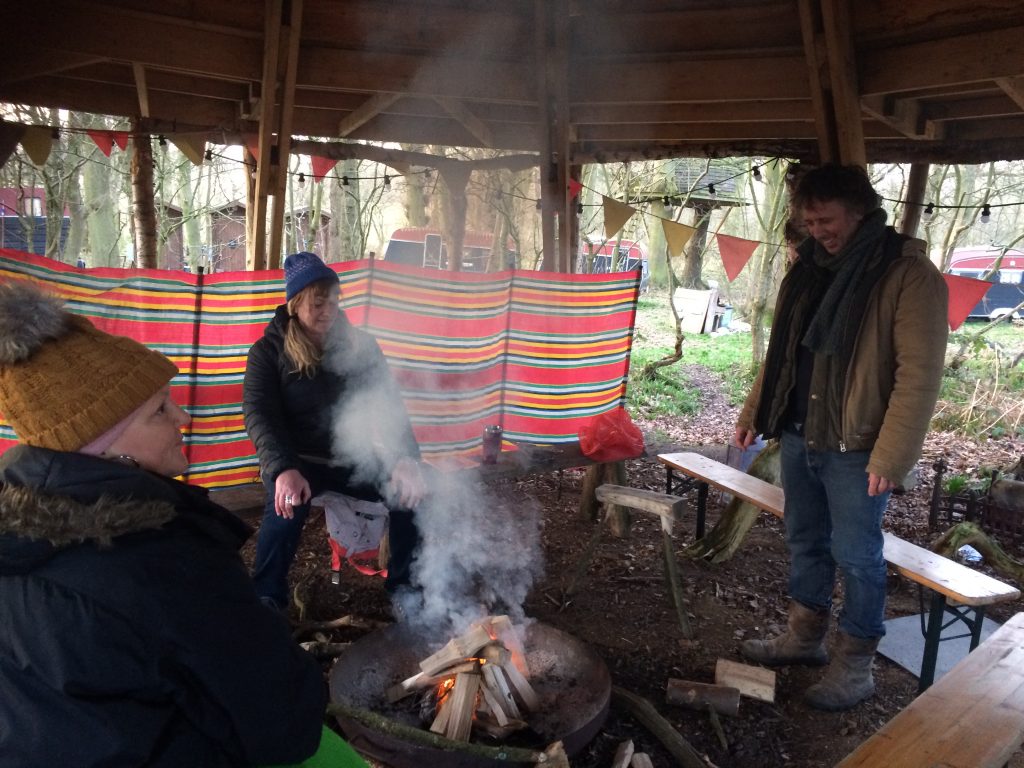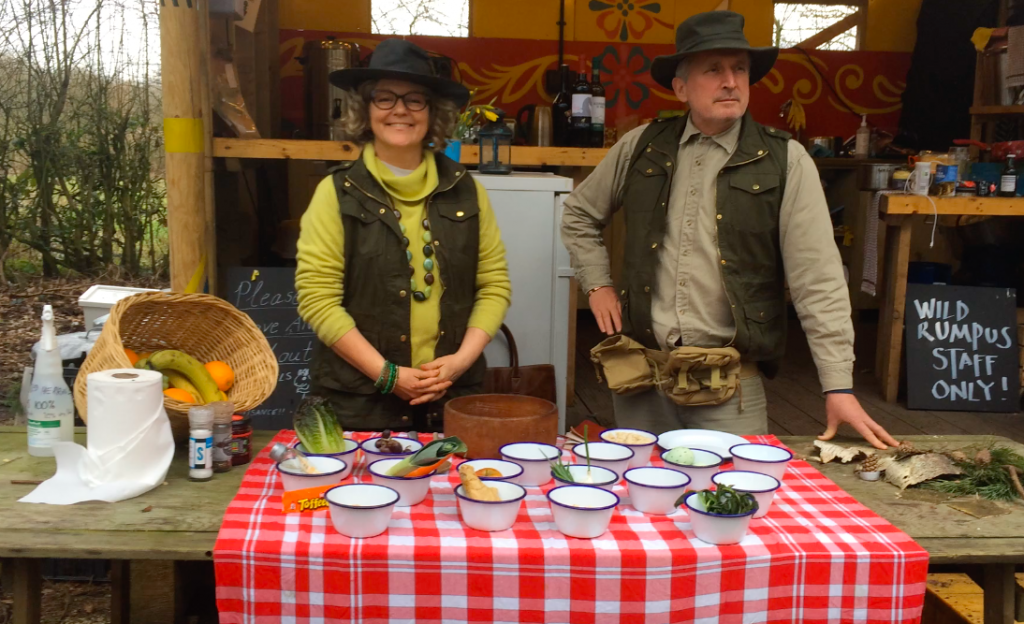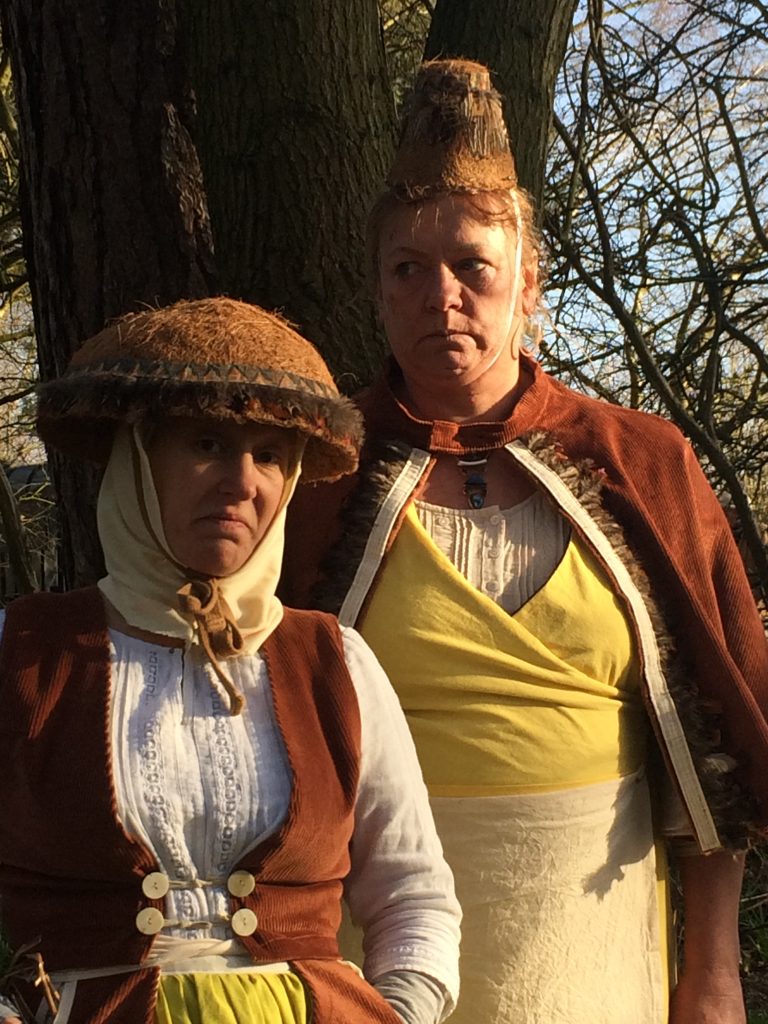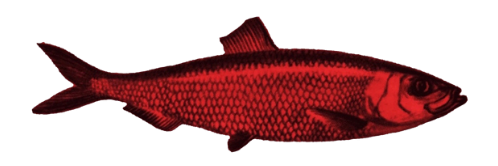Encountering the Whistlers

For 3 days we worked with John Nicholson (of Peepolykus fame). He worked with us for 2 days in March 2020, just before the reality of the pandemic struck and it was satisfying to see how much our ideas and designs had progressed since then. We now have a set of costumes. We have designed the branding around the Whistler Conservation Society. And we have made some decisions about the Whistler culture – a theory of how they came to live in the woods of the Caucasus mountains, a history of encounters with people from a Western and connected world, an understanding of how they live and operate in the wilderness including their communications with the birds and an assessment of their plight in the light of deforestation and climate change.
Our first job was to introduce Robin Lough, a new recruit to the Whistler Conservation Society (played by Barnie Gibbons) to Lynne Passerine (played by Kim Tilbrook). Kim had already made headway with Lynne’s character but Barnie was starting with a fresh sheet and we were keen to know how they could relate together. It turns out that Robin is a real nurd, who’s worked for years in a dull job but has found freedom in his voluntary position with the charity. He feels like the explorer he’s always wanted to be. And he greatly admires Lynne – the founder of the Whistler Conservation Society – who is focused and tireless in the pursuit of the charity’s mission. Nothing will harm the Whistlers on her watch, that’s for sure!

While this was all helpful stuff in terms of making our show, the most beautiful thing was rediscovering the sheer joy and liberation of make-believe – what is essentially the stuff of our job. Robin and Lynne held hands in the sunshine and tears began to flow because of the simple stupidity and the honesty of it all. We’re not here forever but we’re in it together, so let’s make the most out of that human connection when we can get it.

We moved on to the other characters in our project – the Whistlers themselves – who remain a little more elusive at this stage. There are various questions to iron out and we may only really discover the answers through playing with an audience. How conditioned are the Whistlers by their environment and the birds they live with? Are they birdlike? If so, how much? When does ‘birdlike’ become too alien and hard to identify with? Where does weird and comic meet? As is often the case, the answer is most likely around simplicity. Through the characters of the Whistlers, we’re essentially looking to encourage people to be in a place where they’re happy to simply be in the woods and listen.
We played with various different approaches to the relationship between the WCS staff and the Whistlers. Is the charity controlling, keeping the Whistlers contained so as to look after them well, like animals in a zoo? In this case, might the Whistlers get benefits from coming out at certain times. Do they dance for food? Are there opportunities to adopt a Whistler? Or are the Whistlers actually more in control of their situation? Might they actually rob people? Can they disappear when they like? Can they call a flock of geese to whisk them away?
John introduced us to Tribe Meets White Man – unedited footage of some Toulambi people from Papua New Guinea meeting someone with white skin for the first time, the ‘story’ being that the Toulambi believe that the white person is a spirit and approach with wonder and trepidation. Many claim to film, directed by Jean-Pierre Dutilleux, to be a fake. This encounter was filmed around 1993 but before then the tribe is supposed to have met at least three ethnologists. One of them claims that the tribespeople faked the footage in exchange for medicine. Fascinating and pretty dark stuff…
While our Whistler characters have gone on a big journey from Eastern Europe and no doubt have encountered many Western people, we think that it’s useful if they keep themselves as isolated from others as possible and remain relatively naive. One of the moments that worked well was observing a Whistler in conversation with a bird – simple but strangely curious. This position gives us somewhere to go – to indulge in the natural idyl that people living in nature represent (however misplaced) but also to cut across this sensibility if we want them to be more opportunistic and more control of their destiny.
As the show involves Whistler tracking, we wondered what tracks or other evidence they might leave behind them. How subtle might this evidence be? A broken branch here, a twist of grass there could suggest that a Whistler passed this way but is that interesting? Are Whistler bloomers on a line might too brash? As we we’d been discussing a unique type of culture, we explored how they might express themselves artistically. We decided that Whistlers would leave signs on trees and bushes, as other calling cards. They might have a style of birdhouse that they made for their bird companions. They might create ritual spaces, used to mark the feeding or passing of the seasons, or the comings and goings of migrant birds. What transpired was the creation of a lovely Whistler art trail, the kind of thing that would be great to happen upon in a woodland setting. I think we’ll take this one with us.
Thanks to Thor and John for being such thoughtful and mischievous provokers. Thanks to Wild Rumpus for having us on site when things were still very uncertain. Thanks to Barnie, Ali and Kim for being brilliant, bold and weird. Let’s see what the next stage of development has to offer. Will we get to France?
